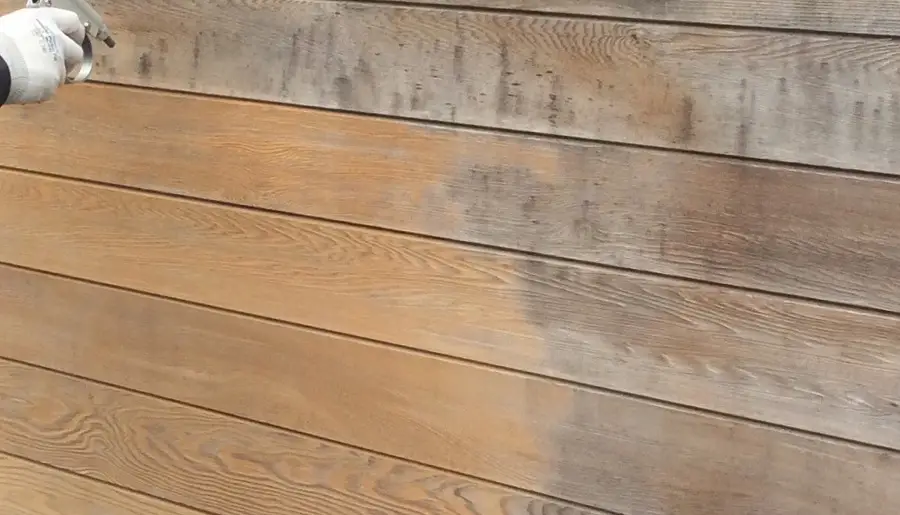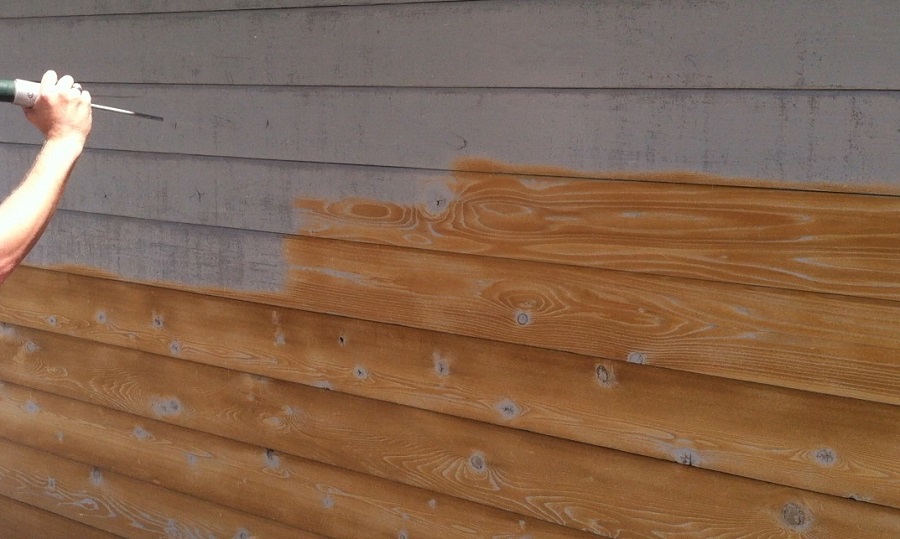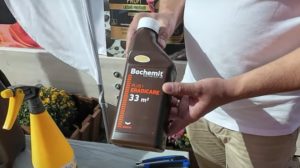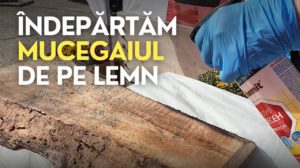"The round log cabin has blackened wood outside in places. Can it be cleaned?" That's the question asked by someone interested in buying the log cabin. The message mentioned that it had never been lived in and I assumed that the wood had not been protected at all on the outside. As a result, the blackness was from dampness, mildew, and the wood naturally changing color under UV rays. The best way to get clean wood in this case is sandblasting, with the recommendation to use a company that specializes in such services. Sandblasting guns and machines are available on the market, some at very affordable prices, leading many people to believe that they can easily do it themselves. But sandblasting is a complex process, and if it's the wood that needs to be sandblasted, things get even more complicated.

Wood sanding
Why is wood sanding more complicated? Because unlike other materials that are homogeneous, wood is a non-homogeneous material, which makes it very vulnerable. Sandblasting wood must be done with great care, taking into account the species, structure, age of the object or the conditions in which it has been stored. The risk is that during the process the wood is irreversibly damaged and the object is compromised. I've seen this here, when old doors were destroyed being sandblasted by someone who had never worked with wood. Which is why Sandblasting is not used for the restoration of wooden heritage objects and is not recommended when the object has been weakened by the weather.
Sandblasting is used in the cleaning, polishing and structuring of various materials, from those used in dentistry to concrete, stainless steel or plastic. It is also used for wood structuring and even to create art objects. The process involves the abrasive, the air or water jet that drives the material and the machine that makes it all possible. For the wood not to be harmed, the quality and aggressiveness of the abrasive material, the pressure used, the distance from the gun to the object and the interaction between all of these must be taken into account. Also, as a process that can generate waste and affect air quality by loading it with very fine particles, choosing natural materials and methods that are as environmentally friendly as possible is also important.
Abrasives and blasting equipment
The first material used in the blasting process was sand. In the meantime, things have evolved, the materials used have diversified and are being used more and more targeted. Now we find as abrasive material glass, ceramic or plastic beads, normal or stainless corundum, glass or metallurgical slag grit, silicon carbide, sodium bicarbonate, salt, vegetable granules. The main difference between them is the hardness set according to Mohs scale which measures the ability of materials to scratch and be scratched.
For wood, do not use materials that are greater than 10 on the Mohs scale, including baking soda, glass, ceramic or plastic beads, granulated pumice, vegetable granules (walnut, corn). Bicarbonate is preferred because it does not damage wood, is non-toxic, environmentally 100% 100% friendly, water soluble (the resulting solution can be discharged into the sewer) and can be used with a compressed air blasting machine.
An increasingly popular material these days is dry or dry ice. Used alone or in combination with other abrasives. Special machines are needed for such blasting, machines that generate the ice particles. If less aggressive blasting is needed, machines can be fitted with systems that break the ice granules making them smaller and less aggressive.
The most commonly used sandblasting machines are compressed air machines. The pressure required is between 2 and 7 bar. There are also blasting machines that use dry steam or water. These have the advantage that they greatly reduce the concentration of dust in the air and the resulting waste is also reduced. However, care must be taken when using them on wood as water can cause problems for the wood. The distance from the gun to the object also influences the sanding quality. By varying the distance and pressure, the best combination can be found to achieve the desired sanding result.

Cleaning weathered wood
If the wood is not protected with materials specially made to withstand the outdoorsr, will be affected by moisture and UV radiation. Moisture creates the conditions for fungi and mold to grow, hence the black color on the wood. It is UV radiation that attacks the dyes in the wood and breaks them down, causing the wood to take on that distinctive bluish-grey color. While the change to gray is only on the surface, and the wood reappears clean when it is removed, with mold things are not as simple. If the water does not drain away, fungi, mold and insects grow and start to enter the wood. It is the cause of deep-seated damage and rotting. Some species are more resistant to this process, others less so. Unless it's a particularly exotic species, it's a good idea to protect the wood outside, make sure the water drains away and doesn't stagnate on it, and air circulates so that the wet wood can dry.
Mildew stain can also be removed with special solutions that can be applied with a brush or spray. The UV-affected part cannot be treated and must be removed. The wood is only superficially affected, and immediately below this spot it is healthy and clean. Removal can be done by hand or mechanical sanding or sandblasting. When the surfaces are large and difficult, such as in log homes, other types of wooden houses, or veneered areas, sandblasting is the most suitable solution.
Removing old layers of paint
If you use sandblasting to remove old layers of paint from doors, windows, door frames or furniture it is very important to know what wood is under the paint. Hardwoods such as oak, walnut or ash are much easier to clean than resinous or lime, which can be easily attacked and structured. A well done sanding leaves the wood clean and smooth, with no raised grain to feel when running your hand over it. Before starting the process, check that the objects have not been damaged by the weather (they are light and break easily), in which case sandblasting is not a solution.
Sandblasting is very effective for carved wood, ornaments, where there are hard-to-reach places. On such objects, the usual methods such as sanding, chemical etching, hot air followed by scraping (methods about which you can find more information here), do not give satisfactory results. In this case too, the fragility of the wood must be taken into account. The best strategy is to remove the paint gradually, by several passes with a sandblasting gun. Lacquer, paint or resin layers can be removed in this way. Paint is more difficult to remove than varnish because of the resistance of pigments.
I hope you find the information useful. If you have any additions, clarifications or questions, please leave them below in the space provided. I will certainly reply.




































Hello!
What oil do you recommend for outdoor oak elements?
Good evening!
Tung oil, Kreidezeit oil-based lazines, synthetic oils for outdoor use.
I don't recommend linseed oil because it doesn't weather well. It should be refinished after max. 1 year, sometimes even after 6 months.
And in conclusion what we use for sandblasting wood,
In my case, spruce for example.
If cleaning, baking soda.
Hello!
A specialist manufacturer made us a house of unbalanced logs. Please tell us what we should do next.Do we have to clean the wood for the treatments that follow?
Given that the wood is semi-dry, what treatments should we apply and when should we apply them?
Is the oil applied after treatment?
Thank you!
Hello!
If the wood has blackened it should be cleaned because blackness means fungi and mould. If it just has a bluish-grey colour, typical of sunburnt wood, there is no need to clean it unless you don't like the colour. It looks that way because the stains in the wood have broken down from the sun, but the wood hasn't lost its properties. A protective insect-fungicide solution can be applied, and after drying apply outdoor oil.
The best finish for wood that is not completely dry is oil. It still allows water to escape, while protecting against outside water (rain, snow, high humidity).
The recommended treatment in this case is insect-fungicide preventive solutions so that the wood is not attacked by fungi and insects in the future. Generally these products are water-based. After their application it is best to leave the wood for a few days to dry. This way it can absorb more oil and the protection will be better.
All the best!